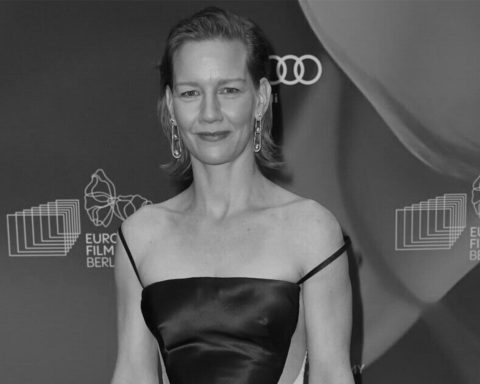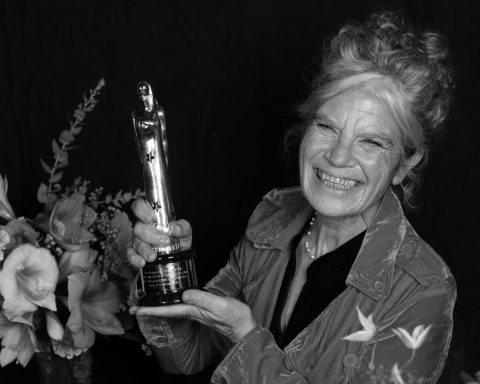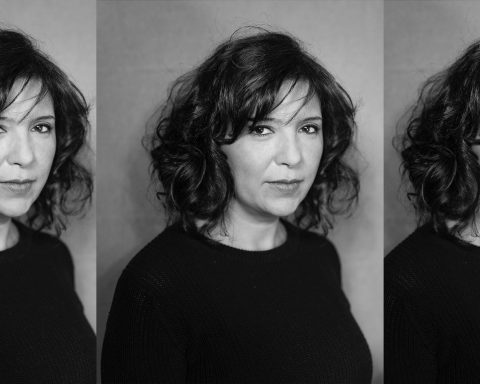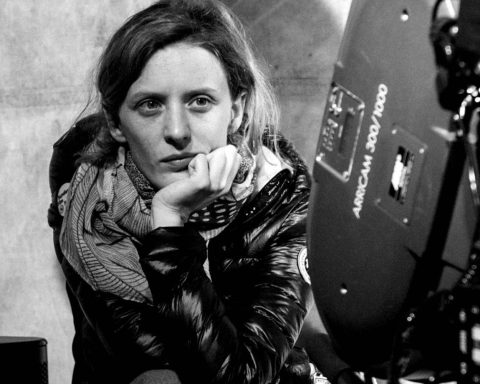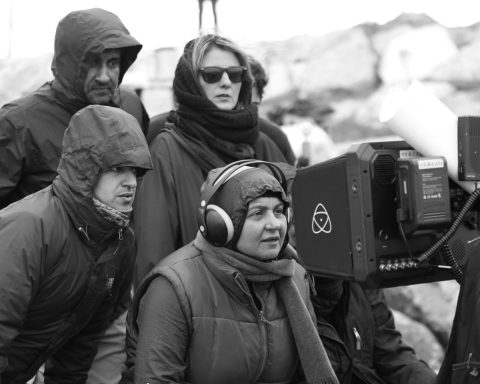Anna Hints is an Estonian film director with a background in contemporary art and experimental folk music. Having deep roots in the distinct culture of South Estonia, Hints’ second home is in India. As an active dumpster diver, Hints’ short documentary “For Tomorrow Paradise Arrives” (2021) initiated public discussion and growth of new grassroot movements against food waste in Estonia.
Tara Karajica talks to Anna Hints about feminism and film and her first feature, “Smoke Sauna Sisterhood,” an intimate, transcendent documentary in which, nestled in the smoky warmth of an Estonian log-cabin sauna, women commune to share naked truths and heal. The film premiered at the 2023 Sundance Film Festival, where it won the Directing Award: World Cinema Documentary and is now screening in the Europe! Voices of Women in Film program at this year’s Sydney Film Festival.
How did you get into filmmaking?
Anna Hints: I think in order to talk about it I have to say that as a teenager, I was really broken. There was a period where I had social phobia and I was really scared of the world and I would stay in my room for quite a while. There was a period I stayed at home for months, basically. We had this satellite that enabled us to watch films and I would watch almost the entire History of Cinema. These stories saved me. They gave me a window to the outside world while being closed inside and they made me feel that voice inside me – the voice of a director – very clearly. It was there when I was little, but when I was broken, I really followed that voice and I also knew that in order to be a filmmaker, I needed to go through a healing journey. That journey took many years. I did Contemporary Art before I studied Photography. I gave birth to a daughter. And then, when I was twenty-eight, I remembered that in my teenager years I wanted to be a filmmaker, that this really resonated with me and I felt the power of this medium where everything comes together. So, I went to film school.
How did Smoke Sauna Sisterhood come about?
A.H.: The roads to that go back to the time when I was eleven and my grandfather had just died. We were in the south. We come from the culture of South East Estonia. My granny, my niece and I all went to the smoke sauna before the funeral, and it was only then and there that my granny shared that my grandfather had actually betrayed her and had lived with another woman. And, she released all these emotions; she released the pain, the anger and frustration. Everything came out. One session in the smoke sauna lasts four hours. I mean, you are in and then you’re out and either you’re listening or supporting the chanting, and washing yourself, sweating it out. I was eleven and I didn’t think I would be a filmmaker then, but it really gave me this deep feeling in my body. So, when we went out, I saw my grandmother had made peace with my grandfather and we could bury him the next day and he could rest in peace. I saw the healing power in that, when you really expose yourself every minute, that you validate all the experiences that you’ve had and all the emotions and you don’t shut them down or shame them. So, it really resonated with me and I think this left this feeling that there is a safe space on Earth. There, absolutely all experiences can be shared and heard and there is a huge healing power and there’s empowerment in that.
In 2015, I was in a monastery with my mom in Thailand in silence during twenty-six days. I have had a very turbulent relationship with my mom. And then, this idea came to me through that experience – my voice was taken away in a way and I couldn’t speak and I remembered not to take my voice for granted. And what does it mean to have a voice? I am speaking to you in my own voice right now; we speak and we say things, but is it really our voice? Who does that voice belong to? Or, do I give a voice to all my feelings or my emotions or my experiences? Or, do I shut them down? So, this inspired Smoke Sauna Sisterhood.
The setting becomes transcendent in the film, and acts as a spiritual refuge for feminine intimacy. Can you comment on that?
A.H.: Yes, you said a very nice thing. When you think about it, the smoke sauna has been that place for centuries because it has been the place where women have really been allowed to be naked in every sense. When you go there, first of all, it’s really about seeking spiritual peace for yourself. It’s spiritual and it’s sacred to go to a smoke sauna for us. The smoke sauna is like a living being and it has a kind of cosmic cloak. And, we even say that every time you go there, part of you dies and part of you is reborn. It has that power of transformation and healing. And, I believe that this kind of mask or whatever you leave behind with things like clothes, you can see it’s not just physical, but also emotional and you peel these layers off and enter there and really find your identity in a way.
These women comfortably exist in their nakedness, both emotional and physical. They share their innermost thoughts on everything from rape and assault to other traumatic experiences, and all of this is very personal, but also very universal. Can you elaborate on that?
A.H.: Yes, that’s very true. I think in Estonia, people are more used to the physical nakedness, but we are not used to being naked emotionally at all. There is still a long way to go for that. Now, when I travel with the film, I go to different places and I see that there are many places where the naked body –especially the naked female body – per se is seen as something sexual. The problem is in the mindset where you look at the nakedness and think that it is sexual. There are many places where the physical nakedness is not okay because it is seen through the objectification of the female body, and so I pay attention to how they watch the film, to how you, as the viewer, are feeling. But this is just a body. We all need to face that. The more I travel, the more I see how deep this issue is and how different societies have sexualized the female body.
Going back to the transcendence of the film, there’s an intensity to it, to that communal experience that is very immersive. How did you shoot it? What were the challenges?
A.H.: It’s so good that you feel it because this has been in my mind all along – how to convey this in an hour and have this experience because of the sweat, the heat… It’s almost like transcending the screen and going to the audience. The average temperature was 80 degrees Celsius, sometimes maybe even 70. It was hot. Because for the purification, the sweating is a very important part and then washing the dirt off the bodies, but also sweating out shame, fears and all these things from our soul. So, it was a total challenge to shoot it. We had a system for that. For example, around the camera, there were ice packs, and we had to adjust not just ourselves to the experience of being there, being vulnerable ourselves and being on the journey, but also adjust the technology. The technology had to be adjusted to the smoke sauna. So, heating the smoke sauna up might take six hours. So, we would first put lenses on the floor. Then, after two hours, onto the first layer of the bench. Then, after two more hours, there was more adjusting. Then, there was another lens outside because you’re in and you’re out all the time, so we couldn’t go with the same lens out; it had to be a different one. Then, of course, the cinematographer had gloves because the camera got wet; there was cold water dripping on his head. For me, as a director, it was what I had to pay attention to a lot. That was an emotionally safe space for the women and I was also part of the women. I was also there naked with them, but I was also trying to make sure that physically nobody got hurt and I had to be very inquisitive and really attentive and I had to feel everything physically and emotionally.
You honor the tradition while painting a contemporary portrait of what is womanhood today, and you combine the two. Can you delve deeper into that?
A.H.: With women’s voices it’s important to give context – where we come from. It’s like the voice of our mothers. My own feeling towards tradition – because I come from tradition – is that when I studied Folklore at University, I realized that actually my grandmother and my ancestors have given me a lot of heritage. I speak the language of the South. And, at some point, I realized that I am one of the carriers of that tradition. But I know that a lot of that is also gone now. I have that inner compass to understand that position on the one hand, but at the same time, I can also see there is a lot of popularity in the traditional ways, but there are things that I don’t take with me to contemporary life. It is like how to take the spirituality of the smoke sauna. It is something that I take there, it is also part of that tradition or that heritage, and it’s not dead; it’s alive. It’s organic, and it should touch and resonate with contemporary people. So, this is the position I myself am in. I am a contemporary person but, at the same time, I have that rich heritage. You have to decide and question what you want to take from that tradition and what not. And, what I take is definitely that spirituality from the smoke sauna. We don’t need to take everything from our ancestors. Actually, the spirituality of the smoke sauna gives you that transformative space to make your own decisions about your life or how you want to be as a woman, or as a non-binary person. I define myself as non-binary, actually. So, it gives me an interesting position to question and, at the same time, make this choice and keep the tradition and respect it. So now, this context is the women who live there now and I am portraying them in the context of or in relation to that existing tradition.
Are you a feminist? If so, how does it inform your filmmaking?
A.H.: You cannot not be a feminist. So, of course, I’m a feminist. Talking about feminism is very important to me. Because I identify as non-binary. We just don’t talk about women or women who were born in the female body. I think, for me, when talking about this, is that I see that the problem is in the mindset and this really goes beyond gender. So, what I think is important is letting people discover their vulnerability that goes beyond gender, that it’s not one type of men or one type of women that society tells us to be, but that there is a spectrum and we have to give a voice to that spectrum and accept the spectrum. Beautiful men are also feminists. People who define themselves as male and are caring human beings define themselves as feminists. So, it’s really about giving a voice. We have to give a voice to various people, and have discussions, not shut them down and not use tradition, or religion or something like this to shut certain voices out because they have been shut out for so long. So, like I said, it is something organic, and our ancestors have also suffered because of tradition. We should redefine all these concepts.
What is your opinion on the situation of women in film today? How is it in Estonia?
A.H.: Oh, there’s still a long way to go! My producer, Marianne Ostrat, said the other day that in Estonia, a lot of producers are women. But she said that this is not because we are so progressive, but because it’s such a really unstable position. There are strong female directors. Space for non-binary or LGBTQ+ – not so much at all. So, there’s still a lot of growing to do in terms of different fields in the film industry. A very long road ahead when we talk about cinematographers, sound recordists, etc., too. I personally think that it is important to make changes, that we pay attention to those things. There are different voices to be heard –female voices to be heard, LGBTQ+ voices to be heard and we should pay attention to that. Also, we have to encourage that from our structures, the committees that make decisions, institutions, schools and so forth.
Do you have a favorite female filmmaker and a favorite film by a female filmmaker?
A.H.: I really like the work of Céline Sciamma. I think one of the last films that I saw several times in the cinema was her film Portrait of a Lady on Fire. I really enjoyed it and it opened more and more layers every time I went to see it.
What are your next projects?
A.H.: There are two short films that I’m completing this year. I also have several ideas at several stages.
Photo credits: Courtesy of Anna Hints.
This interview was conducted in partnership with:

and







